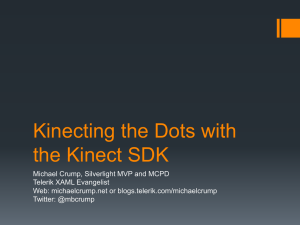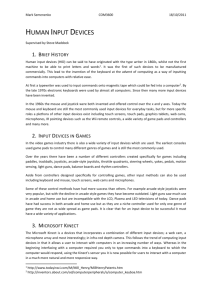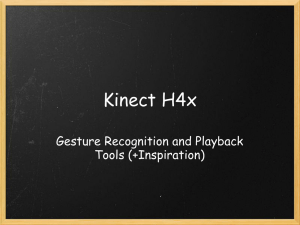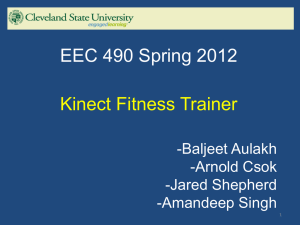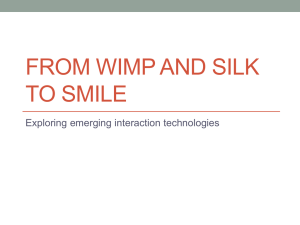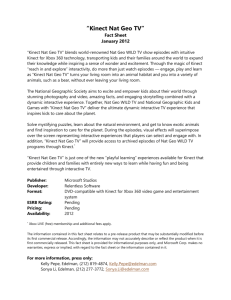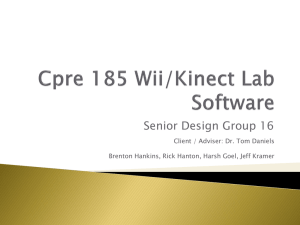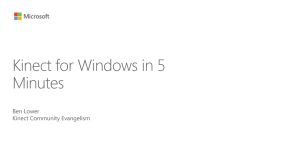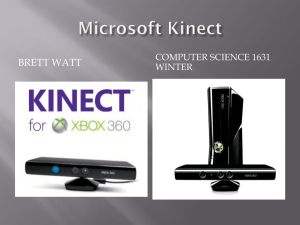KINECT REHABILITATION
advertisement
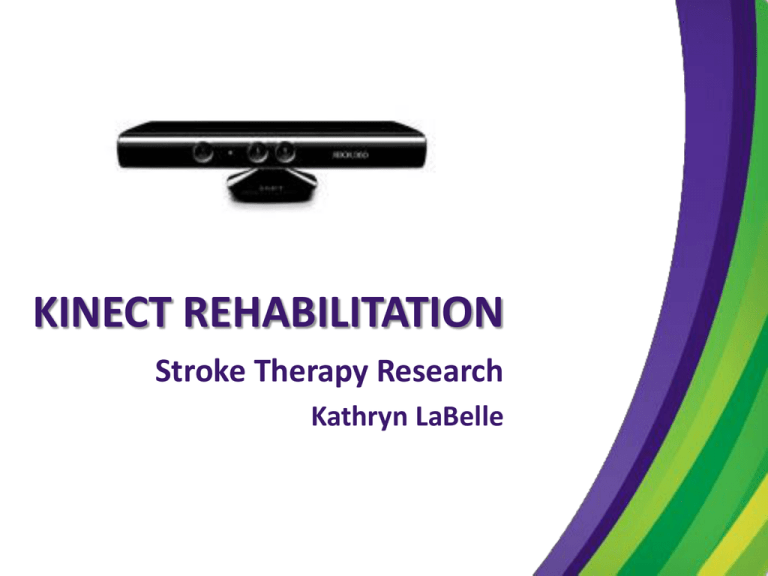
KINECT REHABILITATION Stroke Therapy Research Kathryn LaBelle RESEARCH TOPIC Can the Kinect’s joint-tracking capability be used in clinical and in-home stroke rehabilitation tools? OUTLINE • Background – Stroke Therapy – Kinect • • • • • • Potential of Kinect in Rehabilitation Research Questions Software Data Gathering Data Analysis Conclusions STROKE THERAPY • Stroke survivors can experience: – restricted movement – loss of sense of balance – decreased strength • Regained through physical therapy – balance exercises – range of motion activities – coordination practice MICROSOFT KINECT • Developed for the Xbox 360 gaming console • Tracks your movements: you are the controller • Sensors 1. 2. 3. 4. Depth Camera and Sensors RGB Camera Microphone array Motorized base DEPTH IMAGING • Infra-red projector shines grid of light on the scene, encoded with data. • Light bounces off objects in the scene. • Kinect light sensors receive reflected light. • By analyzing time of flight and distoritions in the encoded data, the Kinect makes a depth map of the scene. JOINT TRACKING ALGORITHM • Input: depth map • Machine learning algorithm – Collected recordings of people using the Kinect – Joint positions marked by hand – Algorithm was fed this “training” data and learned how to correctly identify joints from a depth image • Output: x, y, z joint positions JOINT TRACKING AND STROKE REHABILITATION • Clinical applications: – assess patients’ performance – track patients’ progress – pinpoint areas for improvement • At-home exercise aids: – provides constructive feedback to patients – give encourgement and motivation – generate summary reports for doctors RESEARCH QUESTIONS • What SDKs and drivers are available for use with a PC? • What type of information can be obtained? • What is the quality of the joint data obtained from the Kinect? – Sampling rates – Consistency • How resilient is the Kinect’s joint data and performance to variation in testing conditions? • What functionality could be provided in a stroke therapy application that uses the Kinect? SDK COMPARISON OpenNI Microsoft Raw depth and image data Yes Yes Joint position tracking Yes Yes Save raw data stream to disk Yes No Joint tracking without calibration No Yes Easy installation No Yes Number of joints available 15 20 Quality of documentation Adequate Excellent SOFTWARE DEVELOPED • Display depth video and skeleton • Joint positions and instantaneous frames per second written to file • Balance board integration • Record depth stream to file • Obtain joint positions from recording DATA GATHERING DATA ANALYSIS • Sampling rates of joint position data • Identifying phases of movement from joint positions • Consistency and stability of joint positions SAMPLING RATE OpenNI Microsoft Average Frame Rate (fps) Std Deviation (between trials) Minimum (fps) Maximum (fps) 25.0 19.6 5.8 2.3 9.8 14.1 30.0 23.7 IDENTIFYING PHASES OF MOVEMENT DATA STABILITY Standard Deviation of Joint Positions while Subject is Motionless Joint Head Hip Knee OpenNI (cm) 0.34 0.42 0.70 Microsoft (cm) 1.8 1.2 1.5 DATA STABILITY: Assisted Tests • Clinical therapy often involves an assistant supporting a patient while he performs exercises • Test procedure: – subject begins by sitting alone – assistant joins, putting hands on subject’s shoulders – subject stands up DATA STABILITY: Assisted Tests DATA STABILITY: Assisted Tests DATA STABILITY: Assisted Tests CONCLUSIONS • OpenNI Framework and Microsoft SDK for Windows are best tools to use • Can provide significant functionality in a joint-tracking application – track and record joint positions in three dimensions – display image of tracked joints in real time – integrate Kinect with the Wii balance board • Sampling rate exceeds acceptable level • Phases of movement are easily identifiable from graphs of joint positions • Joint position stability is more than adequate with one subject in view • Skeleton merging could pose a problem for clinical use of Kinect FUTURE WORK • Deeper investigation into assisted exercises – Different types of exercises – Position the assistant differently – Determine conditions causing skeleton merging • Further development of software • Investigate applications in other fields of physical therapy QUESTIONS?


